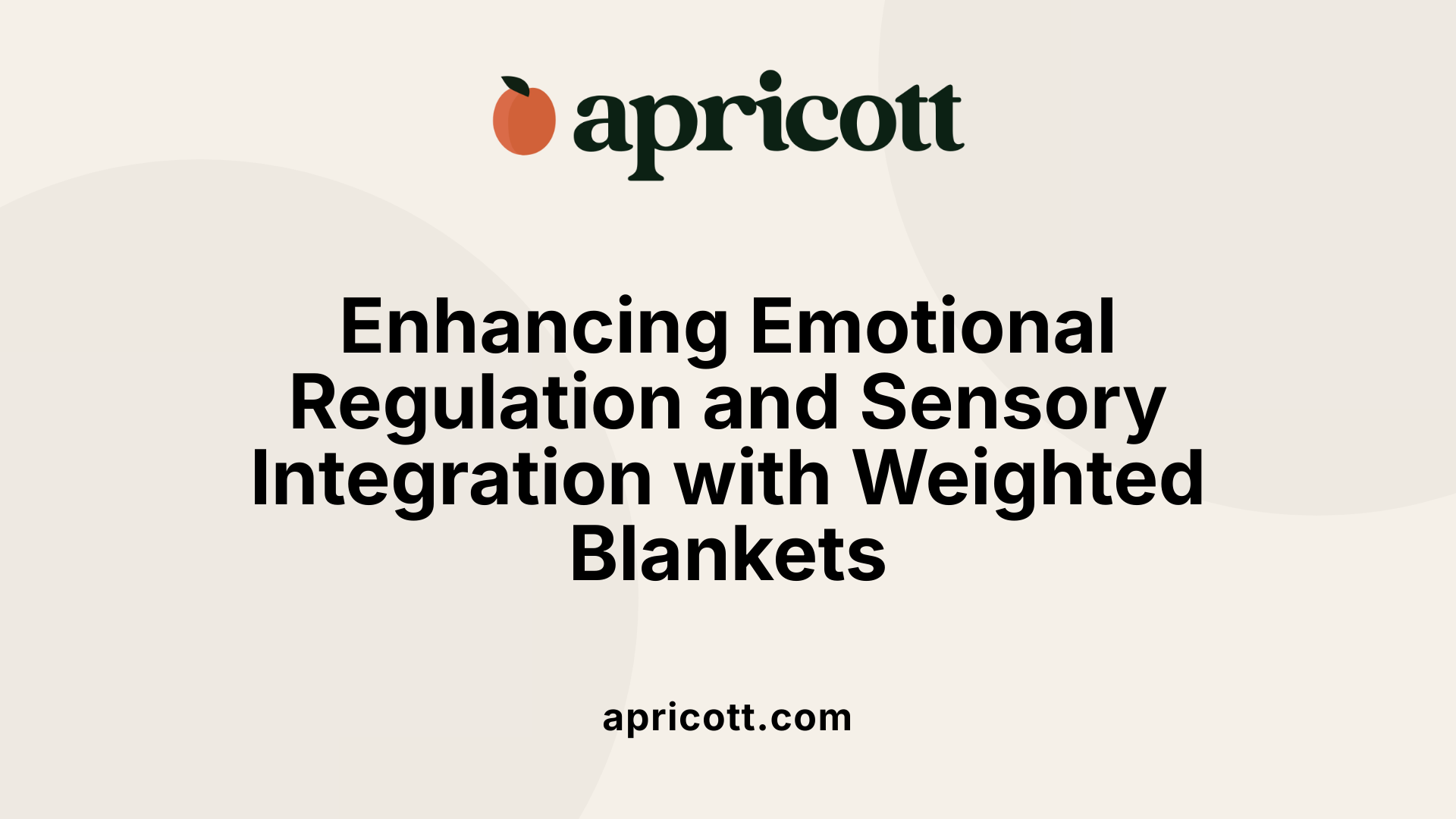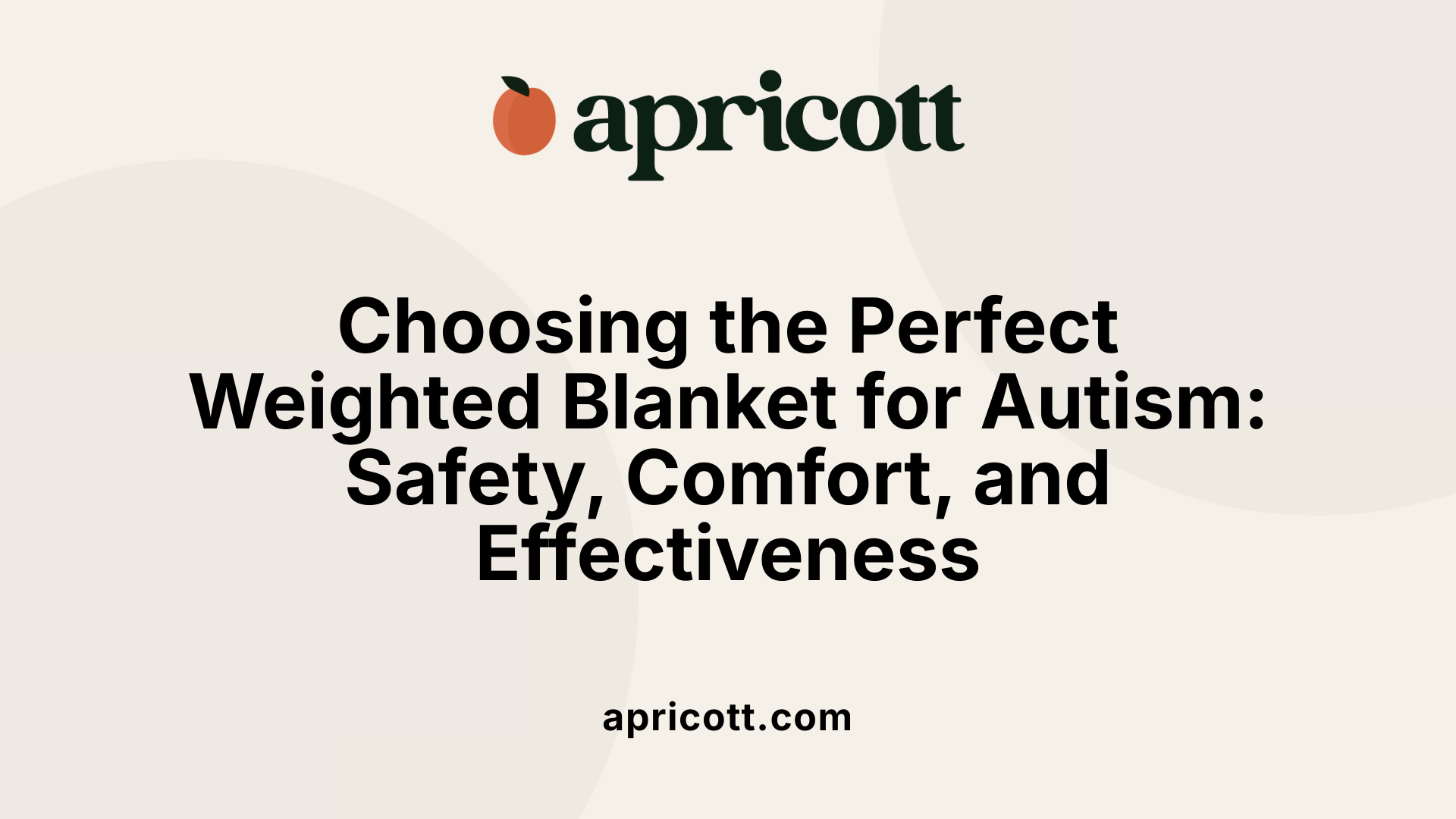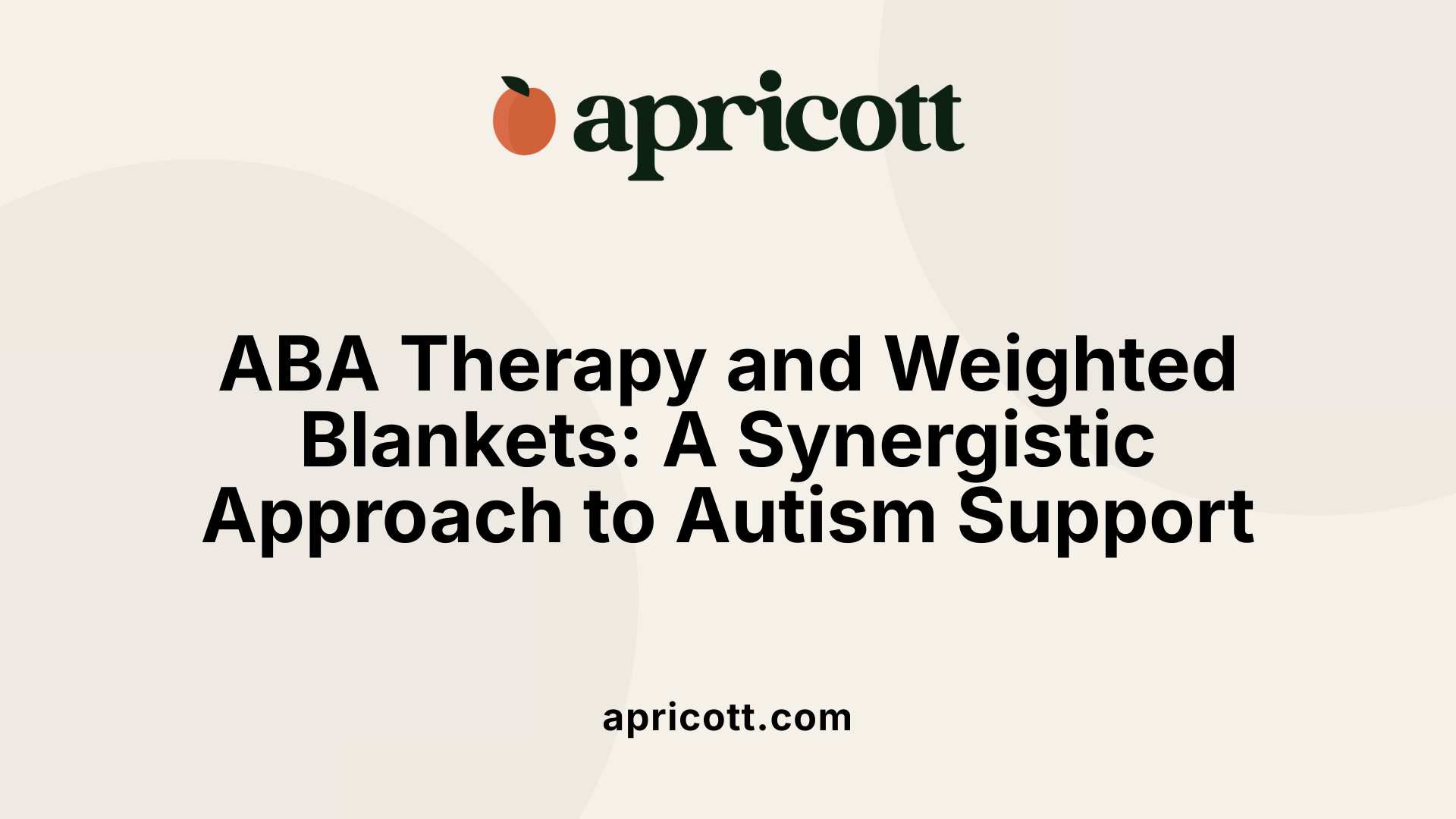December 2, 2025
Exploring the Therapeutic Role of Weighted Blankets in Autism Care
Weighted blankets have become a popular adjunct in therapeutic settings for individuals with autism. Offering deep pressure stimulation, these blankets mimic the calming sensation of a hug and are believed to support emotional regulation, sensory processing, and sleep quality. This article explores the science behind weighted blankets, their therapeutic applications, and how they complement established behavioral therapies in autism care.

Deep Pressure Stimulation (DPS) is the foundational mechanism behind the effects of weighted blankets. This therapy applies firm yet gentle pressure evenly across the body, simulating a sensation similar to a comforting hug. The consistent pressure from weighted blankets activates the body's calming processes without being intrusive.
The gentle compression from weighted blankets stimulates the parasympathetic nervous system, which is responsible for the body's "rest and digest" response. Activation of this system helps to lower blood pressure and heart rate and decrease levels of cortisol, the stress hormone. This shift promotes a state of relaxation, helping individuals calm their nervous system and manage stress.
DPS encourages the release of important mood-regulating neurotransmitters such as serotonin and dopamine. These chemicals help enhance mood and foster feelings of well-being while reducing anxiety and stress levels. Simultaneously, the reduction in cortisol supports a more balanced emotional state and promotes overall mental health.
The pressure from weighted blankets can lead to decreases in blood pressure, heart rate, and cortisol. These changes physically manifest as reduced anxiety and heightened relaxation. Together, these physiological effects help improve emotional regulation and may contribute to better sleep quality by facilitating the body’s transition from alertness into a restful state.

Weighted blankets provide deep pressure stimulation (DPS), which applies gentle, firm pressure across the body. This pressure mimics the comforting sensation of a hug, activating the parasympathetic nervous system—a part of the nervous system responsible for calming the body. This activation helps individuals with sensory processing disorders, including autism, by reducing overstimulation and promoting a calming effect.
Studies show that using weighted blankets can significantly reduce anxiety symptoms in various populations, including those with autism. The deep pressure encourages the release of mood-enhancing neurotransmitters like serotonin and dopamine while lowering cortisol, a stress hormone. These changes help stabilize mood and improve emotional regulation, providing much-needed relief during stressful situations.
Weighted blankets support sensory integration therapy by offering consistent sensory input. This firm and even pressure can help quiet the nervous system, reducing behavioral disturbances associated with sensory overload. Individuals with autism often experience enhanced focus and a greater sense of safety and reassurance when using weighted blankets, which improves overall well-being.
Weighted blankets are carefully chosen based on weight (generally about 10% of the user's body weight for children with autism), material, and fabric to maximize comfort and effectiveness. They are commonly made with breathable, hypoallergenic fabrics and fillings like glass beads for even weight distribution.
Given these benefits, weighted blankets serve as a valuable therapeutic tool to complement other sensory integration approaches, aiding individuals with autism in managing sensory challenges and improving emotional health.

Research exploring the impact of weighted blankets on sleep quality in autistic individuals offers nuanced insights. A 2020 systematic review of eight studies indicated that weighted blankets might reduce anxiety by providing deep pressure that calms the nervous system, potentially supporting better sleep. Some participants reported feeling better in the morning and found it easier to fall asleep, as noted in a 2021 study involving both autistic children and adults.
Despite these positive subjective accounts, objective measures of sleep quality show mixed results. For example, a 2014 study revealed that while participants favored the comfort of weighted blankets, statistically significant improvements in sleep outcomes were not observed. Similarly, the 2021 study did not find notable changes in sleep metrics despite user-reported benefits.
This contrast highlights an important aspect: although weighted blankets may not consistently enhance measurable sleep parameters, the calming effect through Deep Pressure Stimulation (DPS) contributes to perceived relaxation and comfort. The sensory integration theory supports this by suggesting that deep pressure provides a soothing influence on the nervous system, which can promote emotional regulation and a sense of security.
Overall, the evidence suggests weighted blankets offer subjective benefits in sleep comfort and anxiety reduction for autistic individuals, but further rigorous research is needed to establish solid conclusions on their objective impact on sleep quality.
Weighted blankets utilize deep pressure stimulation (DPS), which applies gentle, firm pressure across the body. This pressure can activate the parasympathetic nervous system, leading to calming effects such as lowered blood pressure, reduced heart rate, and decreased cortisol levels. A meta-analysis of psychiatric patients revealed that weighted blankets significantly reduce anxiety symptoms compared to placebo, demonstrating a standard mean difference of -0.47 with a strong statistical significance (p < 0.001). These calming effects provide grounding and reassurance, making weighted blankets a beneficial tool in managing anxiety disorders in clinical settings.
Individuals with chronic pain conditions, including fibromyalgia, may find relief through weighted blankets due to the consistent, soothing pressure they provide. The deep pressure helps modulate pain perception by promoting relaxation and reducing nervous system overstimulation. By helping the body feel secure and calm, weighted blankets can alleviate some sensory discomfort and improve overall well-being in those suffering from persistent pain.
Weighted blankets offer holistic therapeutic advantages by promoting emotional regulation, relaxation, and sensory integration. They mimic comforting sensations like a gentle hug, which supports nervous system calming and emotional balance. Their ability to reduce anxiety, enhance relaxation, and improve sleep quality makes them a versatile therapeutic tool across various populations including those with sensory processing disorders, PTSD, and ADHD. Though more extensive clinical research is needed to bolster evidence, preliminary findings emphasize their promise as an accessible and non-invasive aid to improve mental health and pain management.

For children with autism, it is generally recommended that a weighted blanket be about 10% of the child's body weight. This guideline helps ensure the blanket provides effective deep pressure stimulation without being too heavy, which contributes to comfort and safety during use.
Weighted blankets filled with glass beads are preferred because they offer even weight distribution, enhancing the deep pressure effect. When selecting fabrics, soft, hypoallergenic, and breathable materials like organic cotton are ideal. These fabrics help increase comfort, especially for individuals with sensory sensitivities.
Temperature regulation is critical for ensuring the blanket remains comfortable throughout the night. Choosing covers that are breathable and easy to clean helps maintain a pleasant and hygienic experience. These features can prevent overheating and cater to the specific sensory preferences common among individuals with autism.
Selecting the appropriate size is essential to maximize support without restricting movement. The blanket should fit the user's body adequately, covering them comfortably without excessive bulk. Safety is paramount—blankets that are too heavy or improperly sized can cause discomfort or pose risks, so careful selection aligned with body size and needs is necessary.
By focusing on these aspects—proper weight, quality materials, temperature comfort, and suitable size—weighted blankets can effectively serve as supportive tools for relaxation and emotional regulation in individuals with autism.

Applied Behavior Analysis (ABA) therapy is an evidence-based method that focuses on understanding and improving behaviors by applying principles of learning and behavior. It aims to boost social, communication, and functional skills in individuals with autism.
ABA uses strategies like positive reinforcement, prompting, and the ABC (Antecedent, Behavior, Consequence) model to encourage positive behaviors while reducing undesired ones. The therapy is personalized, tailoring goals and interventions to each person's age, abilities, and needs.
Trained professionals, including board-certified behavior analysts (BCBAs) and registered behavior technicians (RBTs), develop and carry out these individualized programs. They often incorporate parents and caregivers, ensuring support extends beyond therapy sessions.
The approach targets key developmental areas such as language skills, social interaction, self-care, and academic abilities. ABA has strong support from research and health organizations as an effective way to promote progress and improve quality of life for individuals with autism.
While ABA focuses on behavior and skill development, sensory regulation tools such as weighted blankets provide complementary support by addressing sensory processing challenges. Weighted blankets offer deep pressure stimulation, which helps calm the nervous system and improve emotional regulation.
In combination, ABA therapy addresses skill acquisition and behavior management, while weighted blankets help ease sensory overload and anxiety. This interplay supports overall wellbeing by creating a more balanced environment for learning and engagement.
Integrating both approaches can improve the effectiveness of autism support by blending behavioral interventions with sensory calming strategies, enhancing emotional regulation and promoting better sleep and focus.
BCBAs are the primary professionals responsible for designing and overseeing ABA therapy programs. They typically hold graduate or doctoral degrees in psychology, behavior analysis, or related fields. Their role includes developing individualized, evidence-based treatment plans, supervising therapy sessions, and evaluating client progress to ensure effective intervention.
RBTs are paraprofessionals who work directly with clients, implementing the therapy plans created by BCBAs. They collect data on behavioral responses during sessions and help reinforce desired behaviors under close supervision. RBTs undergo specialized training and certification to ensure they can deliver interventions appropriately.
Supporting roles may include Board Certified Assistant Behavior Analysts (BCaBAs), who assist BCBAs with creating and supervising treatment plans. All professionals involved in ABA therapy must complete rigorous training and certification processes and adhere to established ethical guidelines. This ensures that therapy is delivered safely, effectively, and respectfully to clients and their families.
Progress in Applied Behavior Analysis (ABA) therapy is systematically tracked through ongoing data collection and behavior observation. Therapists observe targeted skills and challenging behaviors, using checklists, questionnaires, and rating scales to monitor improvements or setbacks. This allows for objective tracking of developmental milestones and assists in adjusting treatment plans.
Indirect assessments from caregivers provide valuable insights into behaviors across environments. However, these reports need to be supported by direct observations and quantitative measures to ensure accurate interpretation. Incorporating electronic medical records helps visualize progress trends and maintains consistent documentation.
Incorporating sensory tools such as weighted blankets into ABA therapy programs supports emotional regulation and behavioral management. Weighted blankets apply deep pressure stimulation, which can activate the parasympathetic nervous system, promoting calmness and reducing anxiety. Many individuals with autism benefit from this soothing effect, which can enhance focus and decrease behavioral disturbances.
Therapists use weighted blankets alongside behavioral interventions to create a comforting and grounding environment, making it easier for individuals to engage with therapy tasks. Although weighted blankets are not a direct measurement tool, their use can facilitate better emotional regulation, thereby potentially improving observable therapy outcomes.
| Aspect | Method | Additional Details |
|---|---|---|
| Direct measurement | Data collection through behavior observation | Uses checklists, scales, and real-time tracking |
| Indirect assessment | Caregiver reports and behavioral samples | Must be corroborated with objective data |
| Documentation support | Electronic medical records | Visualizes developmental trends and maintains consistent records |
| Sensory tool integration | Weighted blankets for deep pressure stimulation | Promotes relaxation, reduces anxiety, supports emotional regulation |
Weighted blankets offer a promising, non-invasive adjunct to traditional autism therapies by harnessing the benefits of deep pressure stimulation. Though research outcomes on sleep improvements remain mixed, their calming effects on emotional regulation, sensory integration, and anxiety reduction are increasingly recognized within therapeutic environments. When used alongside comprehensive behavioral approaches like ABA therapy, weighted blankets can contribute to a supportive sensory experience, enhancing overall wellbeing for individuals with autism. As further clinical studies refine our understanding, incorporating weighted blankets thoughtfully and safely can become a valuable component of personalized autism care.